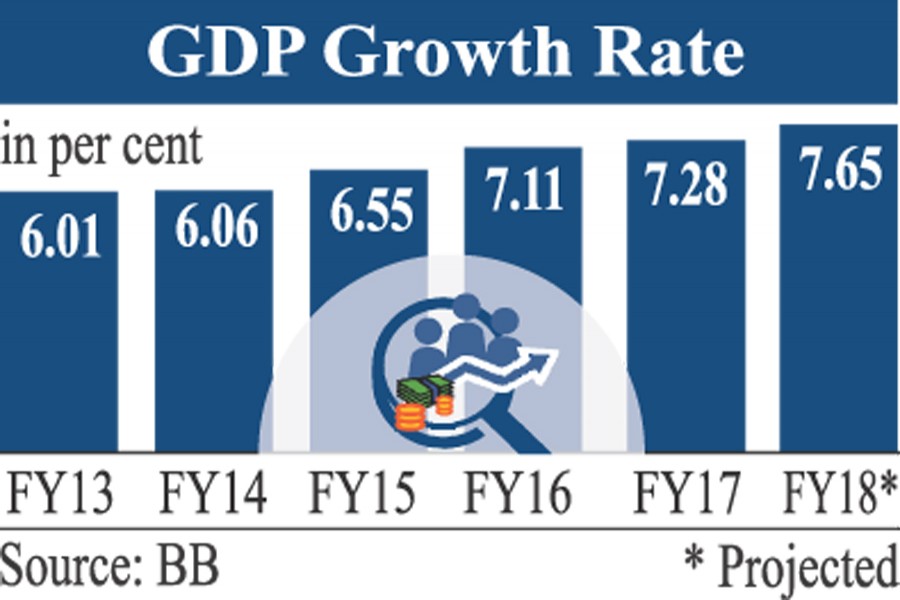
Bangladesh's economic growth rate is expected to hit 7.65 per cent in the current financial year, supported by the industrial and agriculture sectors, the government said Tuesday.
But economists were critical of the provisional growth rate, saying that the real economic activities are not compatible with the BBS's figures.
The gross income per head of the country is also expected to pick up by 8.82 per cent to US$1,752 in the financial year (FY) 2017-18 from $1,610 in the last fiscal year of 2017, the state-run Bangladesh Bureau of Statistics (BBS) said while unveiling its provisional data.
Officials said that the gross domestic product (GDP) growth of the country at constant price has broken all the previous record in Bangladesh's history.
The country joined the rank of the "7.0 per cent growth club" two years ago in financial year 2015-16.
In the FY 2016, Bangladesh's economy expanded at 7.11 per cent rate, breaking past the "6.0 per cent growth trap" after a long nine years.
The 7.65 per cent growth in the current fiscal is even higher than the 7.4 per cent target as set in the current fiscal's national budget.
Planning Minister AHM Mustafa Kamal disclosed the growth data on while briefing reporters after the meeting of the Executive Committee of the National Economic Council (ECNEC) at the Planning Commission in Dhaka.
According to the BBS's data, the country's total GDP size at current price is expected to touch to Tk 22.38 trillion (US$274.49 billion) in the current FY2018.
In the fiscal 2017, the size of the economic output was Tk 19.76 trillion (US$249.72 billion).
The Gross National Income (GNI) has also expanded to Tk 23.38 trillion ($286.68 billion) in the current fiscal from Tk 20.60 trillion in the fiscal 2017.
GNI is calculated incorporating the total remittance inflow with the total GDP to a particular country in the certain fiscal year.
Economist Mirza Azizul Islam told the FE that if the incremental capital output ratio (ICOR) and the investment-GDP ratio are calculated, the country's provisional growth data doesn't match.
"According to the last four years' ICOR calculation, if Bangladesh wants to grow at 7.65 per cent its investment-GDP ratio will have to be 34.85 per cent. But it is interesting that the BBS's provisional data for the investment-GDP ratio is 31.47 per cent. So, the 7.65 per cent growth is not realistic if the ICOR is considered," he said.
Mr Islam, a former caretaker adviser, also expressed his doubt about the per capita income. "If the country's current 1.3 per cent population growth is considered, the GDP will have to be expanded at a rate of 10.3 per cent to lift the per head income to $ 1,752," he said.
He also questioned the agricultural growth in the current fiscal when the country's northern region and north-eastern haor regions had faced flash floods resulting in considerable damage to the crops.
Economist Ahsan H Mansur voiced his doubt over the GDP growth, saying that the macro-economy at this moment is "unstable".
"There is a huge gap between export and import. Demand or consumption has dropped in the economy as the orders at the last Dhaka International Trade Fair proved it," he said.
He continued, "The construction sector has become stagnant over the couple of months due to higher price of steel, cement and stones. The banks are facing liquidity crisis and the foreign exchange rate is unstable. So, with those serious constraints, how can the economy grow at that rate?"
"… It is better to be cautious about ensuring the macro-economic stability rather than showing higher GDP growth rate," Mr Mansur said.
The national statistics agency has estimated the provisional figure based on the available data in the last three quarters (July-March) and considering the statistics of the fourth quarter of the previous years.
"The BBS has taken data from the last three quarters of the year. And it has taken consideration the statistics of the fourth quarters of the previous fiscals," Mr Kamal told reporters.
According to the BBS provisional data on constant prices, the industrial sector is expected to grow at an impressive 11.99 per cent at the end of the current FY2018 from 10.22 per cent in FY2017.
Similarly, the agriculture sector is also expected to expand at 3.06 per cent rate in the current FY2018 from 2.97 per cent in the last fiscal.
However, the growth rate of the services sector was lower in the current fiscal to 6.33 per cent compared to that of 6.69 per cent in FY2017, the BBS data showed.
The contribution to the economy by the industrial and services sector has increased to 33.71 per cent and 7.53 per cent respectively in the current FY2018 compared to 32.42 per cent and 7.36 per cent respectively in FY2017.
The investment-GDP ratio is also expected to grow to 31.47 per cent at the end of the current FY2018, compared to 30.51 per cent in FY2017, the official data said.
When asked about the higher GDP growth, the planning minister said: "The investment, exports, and remittances have picked up this year along with the impressive industrial sector growth. Besides, the government has been handling the macro-economy in a matured way. These factors have expanded our economy."
He expressed the hope that the final GDP growth data after the completion of this financial year will surpass the provisional data.
kabirhumayan10@gmail.com
© 2026 - All Rights with The Financial Express
